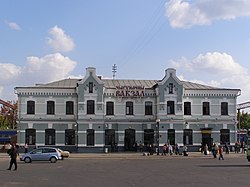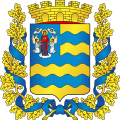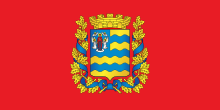Minsk Region
Minsk Region or Minsk Voblasć or Minsk Oblast (Belarusian: Мі́нская во́бласць, Minskaja vobłasć [ˈmʲinskaja ˈvobɫasʲtsʲ]; Russian: Минская о́бласть, Minskaja oblastj) is one of the regions of Belarus. Its administrative center is Minsk, although it is a separate administrative territorial entity of Belarus. As of 2011, the region's population is 1,411,500.[1]
Minsk Region Minsk Oblast, Minsk Voblast | |
|---|---|
 Railway Station, Barysaw | |
 Coat of arms | |
 | |
| Administrative center | Minsk |
| Largest cities | Barysaw - 150,400 Salihorsk - 101,400 Maladzyechna - 98,514 |
| Raions | 22 Cities - 22 Urban localities - 20 |
| City raions | 8 |
| Government | |
| • Chairman | Anatoly Isachenko |
| Area | |
| • Total | 39,912.35 km2 (15,410.24 sq mi) |
| Highest elevation | 345 m (1,132 ft) |
| Population (2011) | |
| • Total | 1,411,500[1] |
| • Density | 35/km2 (90/sq mi) |
| Area code(s) | +375 17 |
| ISO 3166 code | BY-MI |
| HDI (2018) | 0.834[2] very high · 1st |
| Website | www |
Geography
Minsk Region covers a total area of 39,900 km²,[1] about 19.44% of the national total. Lake Narach, the largest lake in the country, is located in the northern part of the region. There are four other large lakes in this region: Svir (8th largest), Myadel (11th largest), Selyava (14th largest) and Myastro (15th largest).[3] It is the only region of Belarus whose border is not part of the international border of Belarus.
History
From the beginning of the 10th century, the territory of the current Minsk Region was part of Kievan Rus'; later, a part of the Principality of Polotsk; then, was absorbed by the Grand Duchy of Lithuania after its formation. With the unification of the Grand Duchy of Lithuania and the Kingdom of Poland, the territory became part of the Polish-Lithuanian Commonwealth.
In 1793, as a result of the second partition of Polish territory, the area was annexed by Russia as the Minsk Region. During the collapse of the Russian Empire and the Civil War, the western part was annexed to Poland in 1921, while the east became Soviet Belarus.
The Minsk region was formed on 15 January 1938 based on an amendment of the Constitutional Law of the USSR. As of 20 February 1938, the area included 20 districts. Following the Soviet invasion of Poland on September 17, 1939, the former Eastern lands of the Second Polish Republic were annexed in accordance with the Molotov–Ribbentrop Pact partitioning Poland and added to the Minsk Region.
On 20 September 1944, by the decree of the Presidium of the Supreme Soviet of the USSR, the Gressky, Kopyl, Krasnoslobodski, Luban, Slutsky, Starobin, Starodorozhski districts and the city of Sluck were removed from the Minsk region and transferred to the newly formed Bobruisk Region.
On 8 January 1954, by the decree of the Presidium of the Supreme Soviet of the USSR, the Nesvizhski and Stolbtsovsky districts from the abolished Baranovichi Region, as well as the Glusk, Gressky, Kopyl, Krasnoslobodski, Luban, Slutsky, Starobin, Starodorozhski districts and the city of Sluck from the abolished Bobruisk Region, were appended to the Minsk Region.
In 1960, following the abolition of Molodechno Region, its southern part became the northern part of the Minsk Region.
Tourism
The number of travel agencies in Minsk Region grew from twelve in 2000 to seventy in 2010.[4][5] The most popular tourist destinations of the region are Zaslavskoye Lake, the Zhdanovichi area which has health resorts, Nesvizh Palace and its surroundings, as well as the alpine ski resorts of Logoysk and Silichi.
Administrative subdivisions
The Minsk Region comprises 22 districts (raions), 307 selsovets, 22 cities, 8 city municipalities, and 20 urban-type settlements.
Districts of Minsk Region
|
|
|
|
Cities and towns
Population of cities and towns in Minsk Region
| English | Belarusian | Russian | Pop. |
|---|---|---|---|
| Minsk[6] | Belarusian: Мінск | Russian: Минск | 1,901,700 |
| Barysaw | Belarusian: Барысаў | Russian: Борисов | 180,100 |
| Salihorsk | Belarusian: Салігорск | Russian: Солигорск | 102,335 |
| Maladzyechna | Belarusian: Маладзечна | Russian: Молодечно | 98,514 |
| Slutsk | Belarusian: Слуцк | Russian: Слуцк | 62,300 |
| Zhodzina | Belarusian: Жодзiна | Russian: Жодино | 61,800 |
| Vileyka | Belarusian: Вілейка | Russian: Вилейка | 30,000 |
| Dzyarzhynsk | Belarusian: Дзяржынск | Russian: Дзержинск | 24,600 |
| Maryina Horka | Belarusian: Мар'іна Горка | Russian: Марьина Горка | 23,400 |
| Stowbtsy | Belarusian: Стоўбцы | Russian: Столбцы | 6,900 |
| Nyasvizh | Belarusian: Нясвіж | Russian: Несвиж | 14,300 |
| Smalyavichy | Belarusian: Смалявічы | Russian: Смолевичи | 14,200 |
| Zaslawye | Belarusian: Заслаўе | Russian: Заславль | 13,500 |
| Fanipal | Belarusian: Фаніпаль | Russian: Фаниполь | 13,200 |
| Berazino | Belarusian: Беразіно | Russian: Березино | 13,100 |
| Lyuban | Belarusian: Любань | Russian: Любань | 11,800 |
| Staryya Darohi | Belarusian: Старыя Дарогі | Russian: Старые Дороги | 11,700 |
| Valozhyn | Belarusian: Валожын | Russian: Воложин | 11,400 |
| Lahoysk | Belarusian: Лагойск | Russian: Логойск | 11,000 |
| Kapyl | Belarusian: Капыль | Russian: Копыль | 10,700 |
| Kletsk | Belarusian: Клецк | Russian: Клецк | 10,600 |
| Chervyen’ | Belarusian: Чэрвень | Russian: Червень | 10,500 |
| Uzda | Belarusian: Узда | Russian: Узда | 10,000 |
| Krupki | Belarusian: Крупкі | Russian: Крупки | 8,300 |
| Myadzyel | Belarusian: Мядзел | Russian: Мядель | 7,100 |
Demographics
.png) Belarusians in the region>95%90–95%85—90%80–85%<80%
Belarusians in the region>95%90–95%85—90%80–85%<80%.png) Russians in the region>10%8–10%5–8%<5%
Russians in the region>10%8–10%5–8%<5%.png) Poles in the region>15%5–15%2–5%1–2%0.5–1%<0.5%
Poles in the region>15%5–15%2–5%1–2%0.5–1%<0.5%
See also
- Administrative divisions of Belarus
- Villages in Minsk Region
References
- "Territory and population density of Belarus by region as of January 1, 2011. Main Geographic Characteristics of the Republic of Belarus". Land of Ancestors. the Scientific and Production State Republican Unitary Enterprise “National Cadastre Agency” of the State Property Committee of the Republic of Belarus. 2011. Archived from the original on 27 September 2013. Retrieved 30 August 2013.
- "Sub-national HDI - Area Database - Global Data Lab". hdi.globaldatalab.org. Retrieved 2018-09-13.
- "Main characteristics of the largest lakes of Belarus". Land of Ancestors. Data of the Research Laboratory for Lake Study of the Belarus State University. 2011. Archived from the original on 29 September 2013. Retrieved 29 September 2013.
- Ministry of Sports and Tourism of the Republic of Belarus. (2011). "Number of organizations engaged in tourist activities in 2010 in Belarus". Land of Ancestors. National Statistical Committee of the Republic of Belarus. Archived from the original on 13 October 2013. Retrieved 9 October 2013.
- Ministry of Sports and Tourism of the Republic of Belarus. (2011). "Number of organisations engaged in tourist activities in Belarus by region". Land of Ancestors. National Statistical Committee of the Republic of Belarus. Archived from the original on 13 October 2013. Retrieved 9 October 2013.
- Seat of the Minsk Region but administratively separated
External links
| Wikisource has the text of a 1911 Encyclopædia Britannica article about Minsk Region. |
![]()
